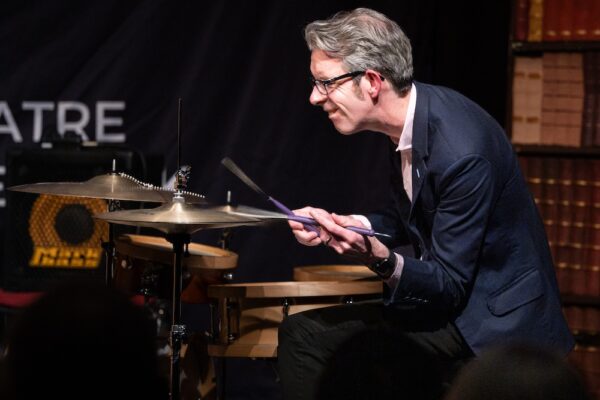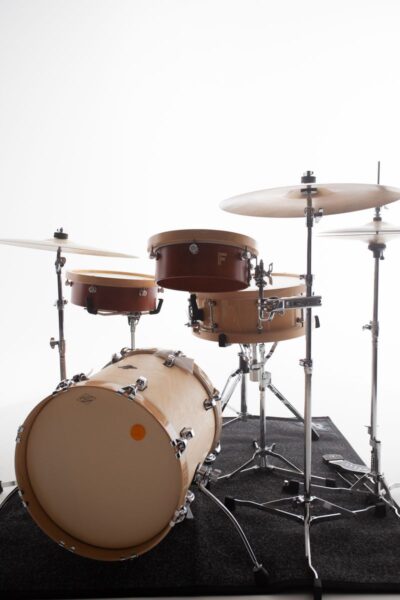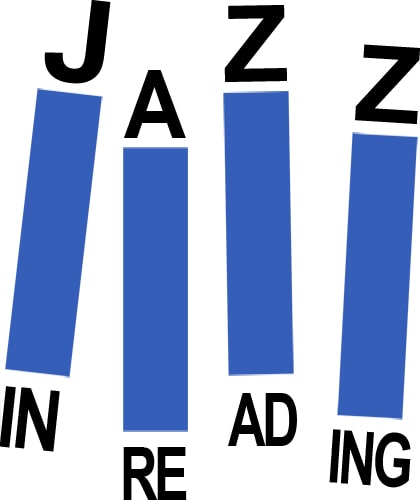
Picture credit: Steve Foster
Ronnie Jones’ drum kit – and approach to drumming – prompted much interest when he appeared with The John Horler Trio at Jazz at Progress on 16 May 2025, so we invited him to tell us more about his world of percussion…
What a special gig it was at The Progress. Thanks to Jazz in Reading and everyone involved behind-the-scenes at this special venue. There was so much warmth from the audience. John, Alec and I felt it on stage; a wonderful, enjoyable evening.
And it’s great to hear some of the audience noticed my drums. I suppose in some ways my kit is a bit unusual; but in other aspects, my setup is part of a trend which goes back a surprisingly long way, as I’ll explore here.
For all drummers, picking the right drums/cymbals is ‘a journey of discovery’. Over the years, we identify what works for us, and our style of playing.
As these elements evolve, so too our taste of drums/cymbals change; which influences our choices.
Here is a breakdown of what I currently play:
Snare drum: 14” x 4.5” Premier Modern Classic (maple) + Canopus hoops (maple).
Bass drum: 16” x 14″ Liberty Drums ’Slim Kick’ bass drum (birch).
Toms: 10″ x 4″ + 12” x 4″ Farmer Drums – a family-run US drum manufacturer, based in Michigan (whose drums I happen to endorse) – maple shells + maple hoop.

Picture credit: Edwin Ho
Note: these toms have shallow shells and don’t have a bottom head – they look a bit like bongos (or wooden rototoms, for any drummers out there). I can’t tell you what a great find these diminutive toms have been. They’re very shallow (compared to ‘normal’ toms); yet the sound is surprisingly resonant, rich and deep. I’m often asked about them after gigs.
Cymbals: 19” Dream Cymbals ‘Vintage Bliss’ crash/ride; 18″ (1960’s?) vintage Zildjian Avedis crash/ride (with Meinl ‘bacon’ sizzler); Zildjian Avedis ’New Beat’ hi hats (14”).
Hardware: DW 6000 UL (‘ultra-lite’) flat-base cymbal stands; snare stand (for Farmer floor tom) & hi-hat stand; DW 6000 flat-base snare drum stand; DW 5000 bass drum pedal.
Drum heads: Remo Fiberskyn ‘Diplomat’ snare head (batter); Evans ’56 bass drum heads w/felt strip dampening; Aquarian ‘modern vintage’ (Farmer toms).
In general, the sound I’m aiming for is a ‘bop’ drum kit – think: higher pitched drums, plenty of natural resonance, minimal dampening, darker sounding cymbals.
So quite a ‘retro’ sound.
But my choices are also informed by what I want to be able to do when I play.
I’ve always found dynamics and texture interesting. This might come from my background in orchestral percussion (more later). By focusing on these elements, I find I’m able to adequately express myself; to ‘let go’ and to fall in to a ‘flow’ state, where my playing becomes instinctive.
I think the joy of Bill Evans’ music (perhaps the reason why so many people from all over the world ‘dig’ it so much) is that it encourages this state of mind – in the musicians who play it; and audiences who listen to it.
We’re feeling the same thing… it’s a knowing; a kind of empathetic telepathy; an emotional synergy. We don’t experience ‘tandem transcendence’ like this very often.
In many ways, I think my job – informed by my choice of drums/cymbals – is about setting the conditions to enable this satisfying feeling to emerge. I draw as much from the audience as the band when I soak up these vibes – it’s a cycle; we feed off each other.
In practice, this might mean I play part of a song with brushes (perhaps scraping the cymbal with the metal ring on the end of the brush; or using the brush’s rubber shaft to strike the edge or bell of the cymbal); then quickly switching to timpani-like mallets (or to my hands) to execute a ‘washy’ cymbal roll; before perhaps flicking a cymbal (or the half-opened hit-hats) with my fingers, fingernails, or wedding ring (don’t tell my wife)…
… whatever instinctively feels right at a given moment – sound, texture, dynamics and timbre considered; reflecting what I’m feeling – and all directly influenced by what my choice of drums, cymbals, drum heads and implements enable me to play.
How so? For example, if my cymbals were too dense; or the drum heads too thick, neither would resonate when I hit them with my hands – nor would they be as responsive to sensitive, deft/subtle strokes; especially when I’m trying to play as quietly as possible. Wooden rims on drums aren’t just kinder to my hands (I used to accidently cut myself on metal drum rims – not a good look); but they also make a more pleasing (less piercing) ’rim shot’ sound, to my ear.
This is why my choices of drums/cymbals/tuning/dampening are so important. It’s the same for all drummers… with myriad variables/options available, identifying what works for us takes time and thought to understand. Like any trade/craft, it’s about identifying ‘the right tools for the job’.
I suppose this is at the heart of the discerning choices which we all make as drummers. You might call these decisions ‘artistic’; selecting instruments to influence the sound or feel which we’re able to produce/create.
But practical considerations are also important: smaller drum kit + lighter hardware = easier loading/unloading!
This genuinely makes a difference.
Every time I load my drums into my car – a Skoda Fabia estate – I get a little dose of satisfaction. No doubt some of this is the excitement/nerves of the impending performance (loading the car was one of the things I missed most during Covid lockdowns, perhaps for this reason); but it’s also about the strangely gratifying fact that my whole kit – drums, cymbals, stands, drum seat and bass drum pedal – fits perfectly in the boot.
This is extremely useful: it means my kit isn’t on display – read: less likely to get ‘nicked’ – if I leave the car unloaded at any point. Also, with the drums tucked neatly in the boot, the back seats are empty, so I can take the kids to gigs; or take the drums on holiday with us – I can’t tell you how much my wife loves it when I do this (there was a memorable occasion when I took the drums to Cornwall with us for a fortnight, so I could play a gig at St Ives jazz club whilst we were away. Only I fell badly whilst running on the SW Coast Path and ripped a rather large hole in my palm, which meant I couldn’t play the gig).
It is partly for these practical reasons that I have intentionally tried to create the lightest drum kit I can get away with (without adversely affecting the sound, as explained above). Example: both of my Farmer toms fit inside one piccolo snare drum case – tidy. This helps me to shift the whole kit with just two trips from the car (without running the risk of a pre-gig hernia in the process).
A small kit is also handy when I’m playing in tiny venues. I used to have a regular gig at a gin bar in Exeter, where the only available space for my (guitar) trio was behind the narrow main door. I had a 16” x 8” bass drum especially made so we’d fit in – anything to secure a booking!
A small kit is also less obtrusive when I set my drums up in the living room to practice (my wife loves this, too).
So, for both practical and artistic reasons, for me – and many drummers – smaller kits just make sense.
But we’re not the first to have come to this conclusion.
Smaller drum kits have always been available – and played by jazz drummers. This insightful article in Drum Magazine documents Elvin Jones’ choice of 18” – and sometimes 16” – bass drums as far back as the late 1950s; pioneered by drum manufacturer, Gretsch (more about the great Elvin Jones later).
But it’s probably fair to say smaller-sized kits were more unusual back then. According to the above article, Buddy Rich and Louie Bellson once went to watch Elvin Jones play at Ronnie Scott’s – sitting in the front row, right at the end of his bass drum (imagine that, fellow drummers!). Buddy apparently nudged Louie at one point to say something appreciative about the sound of Elvin’s small bass drum (both Buddy and Louie played big 24” bass drums).
In the last decade or so there has definitely been a shift towards smaller kits – and a corresponding ‘push’ from manufacturers to cater to these changing tastes (or maybe it was the other way around?).
Either way, this means my drum kit setup isn’t as unusual or unique as you might think; many drummers have come to the same conclusion and calculus regarding sound and practicality.
That said, I must admit aesthetics have also driven my decision-making. I recently heard a drum manufacturer refer to their new drum kit release as ‘… a beautiful piece of furniture’ (or something like that).
I thought that was rather insightful – I’m not the only drummer who loves how their kit looks as well as how it sounds (though if a reviewer wrote that about my playing, I’d be less than impressed).
Obviously, the colour of the drums has no impact on how they perform acoustically. These decisions are squarely (roundly?) about personal taste.
For example, I love the contrasting colour of my drum kit – the ‘auburn’ tinted oil on the tom shells works so nicely against the natural clear maple hue of the tom hoops, which itself matches the colour of the other maple drums (I’d better stop before I find myself in Private Eye).
I think this looks rather beautiful. It’s a shame to hit it with a stick, really.

Picture credit: Edwin Ho
The same is true with my choice of hardware. I bought the lightweight single-braced stands because they are effortless to carry; but also because they complement the retro ‘bop’ vibe/aesthetic which I’m aiming for… an appreciative nod to the smooth, classy drum kits (and drummers) of the 1950s and 60s.
So, weighing all of this up – sound, practicality, aesthetics – ‘sound’ is probably the most important consideration, for me.
As discussed, dynamics/texture are key to how I approach drumming; informing my choices; helping me to create a sound which – I hope – is recognisably ‘me’. My drums/cymbals help me play how I want to play.
As I mentioned earlier, my appreciation of these musical devices may stem from my background in orchestral percussion – more specifically when I played in Ealing Youth Orchestra as a teenager; an 80 strong symphony orchestra, and a formative influence on my playing – but I also think it has something to do with my willingness to show emption/empathy whilst on stage…
… Alec, John and I were talking about this during the interval at The Progress on 16 May, funnily enough. I’m not the loudest drummer in the world – as the guys know. I told them I think my natural inclination to play sensitively/emotively (introspectively?) is what drew me to the Bill Evans repertoire. I spent years trying to work out what kind of drummer I wanted to be – and searching for a musical outlet which would enable me to play how I felt was ‘right’; music which dovetailed with how I approach the drums – and drumming itself.
I found this outlet when I started playing with this repertoire. Playing Bill Evans’ music doesn’t work unless everyone is willing to ‘let go’; to ‘wear their hearts on their sleeve’; to follow each other; to listen; to break free from convention… I think this mindset is what encourages the interaction/interplay… the transcendence to happen (Evans’ ‘genius genesis’, of course).
What’s so wonderful about playing Bill Evans’ music with John and Alec is that they set the conditions to make this magic happen; by leading by example. They are just awesome musicians – experts at interpreting emotion through their playing. They’re inspiring to play with.
In many ways, playing Bill Evans’ repertoire in this trio has encouraged me to explore the emotional side of my playing more deeply. I’ve had some wonderful feedback from audiences over the years who have kindly mentioned how much our playing has moved them… that’s exactly what I’m trying to achieve when I’m at the drums; and what I think we’re all trying to achieve as musicians in the trio – all musicians, in fact.
I’m obviously far from unique with this approach to jazz drumming. I’m constantly inspired by the greats who worked all of this out – decades ago … and to the legendary players who are still gigging.
I am particularly indebted, of course, to the drummers who played with Bill Evans over the years; the drummers who led the way; drummers like Paul Motian.
I was listening to the album Waltz for Debby last night. Motian’s playing is so unique – the colour from his subtle cymbal rolls (My Foolish Heart is a great example); the virtuosic flicks and rolls with his brushes; the moments of ‘in the pocket’ swing; just when they feel right – so deeply tasteful. When I found this album, what I felt more than anything was relief… relief that it was ‘ok’ to play the way I knew I wanted to. Motian had made that choice already; he led the way.
I feel exactly the same about Elvin Jones. The next time you listen to Coltrane’s masterpiece Ballads (and I encourage you to listen to it – a lot – it’s the soundtrack of our Saturday night dinners, so much so my kids sing along to the solos); tune in to the drums; particularly brushes… so much warmth, so much feel… timeless, inspiring musicianship.
These are guys who aren’t afraid to show emotion – they actively leverage it when they play. Audiences pick up on this. That’s why they’re drawn to the music – it’s as cathartic as it is calming.
Likewise, with Jeff Hamilton – another sensational drummer who is well-known as a brush virtuoso, and rightly so.
I recently found a fascinating interview which Jeff gave a few years ago. If readers are interested to understand what a great drummer like Jeff brings to jazz ensembles, I’d encourage you to watch.
Here are a couple of links: Part 1 | Part 2
I only found these videos a few weeks ago – they are mind-blowing for me; and enormously inspiring. Jeff explains how – and why – he is aiming to play as a ‘musical drummer’. His advice to achieve this: “Sing everything you want to play”.
I can’t tell you how much this has resonated with me.
Jeff – and all the drummers I love – are masterful accompanists. Yes, they’re all virtuosos – but they keep their ‘chops’ close their chest – everything is about the music; about the moment… and – by extension – about the audience.
I think what connects all of them is their intense musicality; their inventiveness; their individuality… and, to a degree, their non-conformity. All of these attributes coalesce to create a unique sound – you instantly know when Paul Motian or Larry Bunker; Peter Erskine or Jeff Hamilton, Mike Clark or Elvin Jones are on a recording. Their playing is an extension of who they are – as people and musicians – their feelings; their emotions; their unique approach.
It is a life’s work to achieve what these guys can do at a drum kit.
And this is exactly what I’m continuing to strive for – always learning; continually seeking opportunities to develop as a player, and as a person – on the lifelong journey of discovery which is: being a musician.
I have a long way to go; but I’ve now got the right instruments to help me to find myself – and what I have to offer – along the way.
